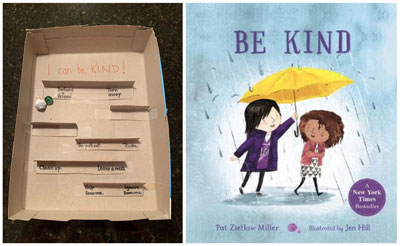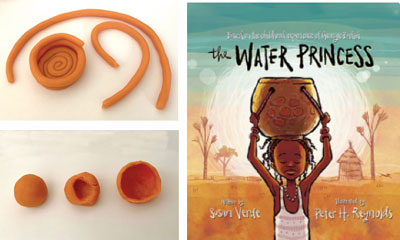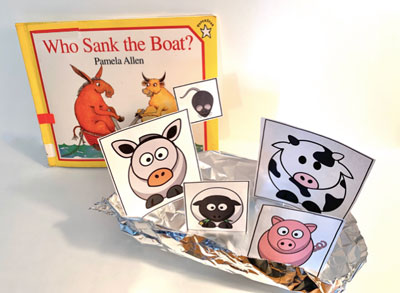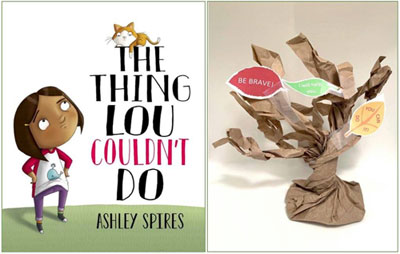
Where hearts, minds and hands meet

When a group of fourth-grade students in our Literacy in the Making* session were asked this question, they had thoughtful responses.
“Sometimes it’s easy, like maybe picking up a piece of trash, but other times it’s hard like when someone is mean to your friend and you don’t know if you should say something.”
“I think it’s hard because you might think you are saying something to be kind, but the person might not see it that way. That’s what happened to Tanisha in the book.”
In Pat Zietlow Miller’s book, Be Kind, Tanisha spills purple grape juice on her dress. The narrator tells Tanisha that purple is her favorite color. She thinks that she is being kind. But when Tanisha simply runs out of the room, she doesn’t understand why.
Instead of considering this simply a plot detail, the students were challenged to think more deeply and critically about the nature and nuances of kindness. When they gave an answer, they were prompted with questions like, “Why do you think that?” or “Can you say more?”
To express their understanding of the text in a more concrete and multidimensional way, the students used recyclable materials to create Kindness Mazes. On each end of the horizontal bars in the maze, the students wrote two opposite behavior choices; one was kind, and the other was the opposite of kind. For example, they wrote, “ask the new student to play basketball” on one side and “ignore the new student and play basketball with your friends” on the other.

Students then added a marble to the maze and tilted the maze to control the marble’s direction, rolling it toward either the kind or the unkind choice. This maker activity highlighted and reinforced the message that students have power to control choices about kindness in their own lives.
The session ended with this question: “How did what you made connect to the story?” This opportunity to reflect on the story, using the theme and the maker activity, is essential to and perhaps the most important part of our Literacy in the Making programs.
For many students, the experience of reading is about answering a series of written prompts, maker projects are focused on STEM activities, and social-emotional skills are discussed in a superficial way. We design our Literacy in the Making activities to challenge these narrowly defined practices by bringing literacy, making and social-emotional skills together, which provides multiple ways for learners to express their understanding of a story.

When students are engaged in a story, they are motivated to understand what is happening. We choose theme-based stories for our Literacy in the Making activities that will not only spark student interest, but also provide a platform for students to engage deeply with the ideas in the text. Researchers Guthrie, Wigfield, Metsala, & Cox (1999) found that students who were motivated preferred to understand text in its entirety. This leads them to process information on a deeper level, which can influence their reading comprehension.
After a shared reading of a book, students engage in dialogue that uses a social-emotional lens to help them more deeply connect to and understand the story. While it may be difficult for students to express and grapple with their own feelings, they are often able to share emotions as they empathize with a story’s characters.
Doyle & Bramwell (2006) found that most classroom reading interactions tend to focus on simple, factual information. However, when they are prompted with meaningful questions, children will respond with rich and complex thoughts and words. These interactions help the students make connections between the feelings in the story and their own feelings and experiences.

Being able to express one’s understanding through making opens possibilities for even deeper expression. The pedagogy behind making borrows from Gardner’s (2011) work on multiple intelligences. Gardner theorizes that people do not have just an intellectual capacity, but have many kinds of intelligence, including musical, interpersonal, spatial-visual, and linguistic intelligences.
In our Literacy in the Making programs, the open-ended nature of the making experience allows space for children to express their understanding of text in ways that make sense to them. As Darling-Hammond (2010) describes, providing students with multiple ways to demonstrate knowledge and skills increases engagement and learning, and provides teachers with a more accurate understanding of students’ knowledge and skills.

Whether the students are making paper bag trees with messages of encouragement after reading The Thing that Lou Couldn’t Do by Ashley Spires, making clay pots as they empathize with Gie Gie from Susan Verde’s The Water Princess traveling with her mother each day to gather water for her family, or creating bridges to support the twenty-one elephants that eased the fears of travelers over the Brooklyn Bridge in April Prince’s Twenty-One Elephants and Still Standing, they are engaging in extended discourse on social and emotional concepts and expressing their understanding through hands-on, concrete making activities.
The combination of literacy skills, social-emotional skills, and making skills provides a way for students to use their hearts, minds and hands to become empowered, creatively confident, future-ready 21st-century learners.
*Literacy in the Making is an interactive, engaging, virtually-delivered program that offers students in grades K-5 the opportunity, through making, to deepen their understanding of literature and explore social-emotional themes such as resiliency, empathy, and self-expression.
Doyle, B.G. & W. Bramwell, W. (2006). Promoting Emergent Literacy and Social-Emotional Learning through Dialogic Reading. The Reading Teacher, v59, n6 p. 554-564.
Gardner, H. (1983). Frames of mind. New York: Basic Books.
Guthrie, J. T., Wigfield, A., Metsala, J. L., & Cox, K. E. (1999). Motivational and cognitive predictors of text comprehension and reading amount. Scientific Studies of Reading, 3(3), 231-256.
Darling-Hammond, L. (2010). Performance Counts: Assessment Systems that Support High-Quality Learning. Washington, DC: Council of Chief State School Officers.

Follow us on Instagram for daily inspiration

Create a thought web, cluster, flowchart, or other graphic organizer for a lesson
8 first projects to get students using technology
Creative, digital book reviews
Fun and powerful ideas with animated characters

Wixie
Share your ideas, imagination, and understanding through writing, art, voice, and video.

Rubric Maker
Create custom rubrics for your classroom.

Pics4Learning
A curated, copyright-friendly image library that is safe and free for education.

Wriddle
Write, record, and illustrate a sentence.

Get creative classroom ideas delivered straight to your inbox once a month.
Topics